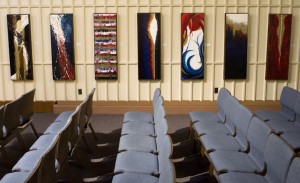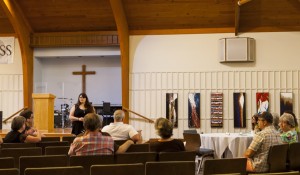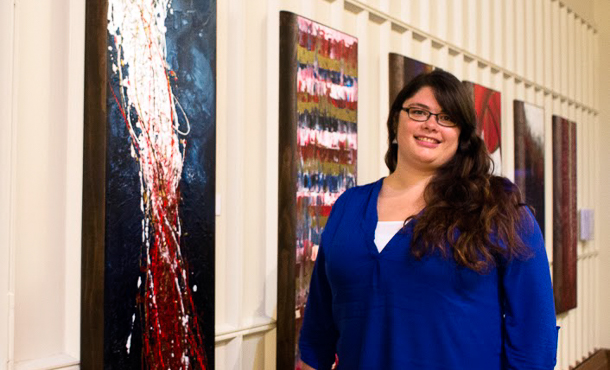When Kathryn Fenton ‘09, MAR ’15, looked for a place to exhibit her artwork, she didn’t have to go far. A Harrisonburg native and long-time attendee of Harrisonburg Mennonite Church, the artist found a familiar local space to debut her seven sacred images that she had created to meet Eastern Mennonite Seminary graduate degree requirements.
Though icons are a tradition of the Orthodox Church, Fenton has transplanted this genre into the context of Mennonite theology. The seven abstract paintings represent the Trinity, the dual nature of Christ, Scripture, Salvation, the Sacraments, Discipleship, and Nonviolence, respectively.
“We have been really blessed by Kathryn’s artwork,” says the church’s associate pastor, Jake Lee. “To have her portrayals adds another level of both attention to the divine and diversified expression of worship.”
One of Fenton’s goals is to continue finding new spaces in which to share her art. Beginning Aug. 30, the icons can be viewed in the sanctuary at Community Mennonite Church (see below for more information).
Urges acceptance of art

Fenton specifically sought an enriching foundation of religious history and theology at the seminary. This foundation in turn informed her project: the exploration and creation of art and iconography, in the context of Mennonite history and theology. The use of art in Mennonite worship or religious activity has historically been negatively viewed, yet this view has shifted in the 20th century.
“Art, like music, dance, and the spoken word, is a form of expression and worship that embraces our embodied nature, glorifying God’s creation,” says Fenton. “The Mennonite church needs to recognize the benefits of bringing art back into the church, using the gift of creativity to profess the word of God, instead of fearing the gift of creativity.”
That fear has never prevented Fenton from making art, from her childhood love of her Lite Brite toy to enrolling in Messiah College, and then transferring to EMU, to study fine art.
Advisor: ‘Art can give expression to Christian faith’
Through acrylic paint, a shattered mirror, symbolic color schemes, and intensive study of various Anabaptist confessions of faith, Fenton illustrates her interpretation of the “seven pillars of Mennonite theology.”
Each of these tenets focuses on the Christian’s interaction with God and active spirituality: scripture is authoritative directly to readers without clergy’s intermediation; salvation is a light universally available; discipleship is an active, collaborative effort to model the Messiah. Fenton’s theology, much like her views on worship, emphasizes hands-on participation.
“She sketched her intended study as building on the understanding of the incarnation as an important tenet of Christian faith,” says her advisor, professor of church history Nate Yoder. “Kathryn works from the premise that art can give expression to Christian faith in ways that echo the meaning of the Word becoming flesh in the person of Jesus Christ.”
Integrating legacies of art and expression

Wood panels serve as canvases, a symbolic nod to the Mennonite folk art of woodworking. Her aesthetic inspirations – Barnett Newman and Mark Rothko – are echoed in bold, expressionistic style.
“I chose abstract instead of the traditional style of icons to honor our tradition of prohibiting representational religious images based on Exodus 20:4,” says Fenton.
Color holds as much if not more significance than form in these paintings – gold representing holiness, white the transfigured Christ, red the body and blood of Christ, and blue heaven and cleansing water. Fenton explains that her “color choices are inspired by the tradition of symbolism in religious images throughout history.”
“Her exploration of icons from traditions associated with Eastern Orthodoxy was particularly poignant as it grounded her own artistic expression in a deep tradition rooted in centuries of development,” explains Yoder.
Artwork and education continues
When not working at the Dayton office of Park View Federal Credit Union, Fenton is in the midst of several new art projects.
She’d like “to continue working with local churches on bringing art and theology together,” and would like to see her icons continue to tour area Mennonite churches.
Fenton is still exploring how to best use her art to supplement the church’s repertoire of spiritual expression.
“My hope is to be able to serve the church as an artist by creating art and creating a space for art to be valued and to enrich the life of the church,” she says. “I believe it is my duty to serve the church with the gift God has given me.”
From Aug. 30-Nov. 22, the icons will be displayed in the sanctuary of Community Mennonite Church in Harrisonburg, open Monday through Friday from 9 a.m. to 4:30 p.m. Churches interested in exhibiting Fenton’s work can contact the artist at lkathrynfenton@gmail.com.
